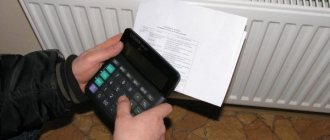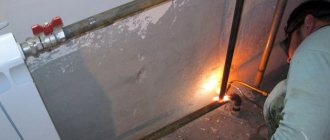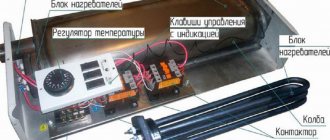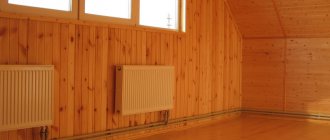In accordance with the Decree of the Government of the Russian Federation dated 05/06/2011 No. 354 (as amended on 03/02/2021) “On the provision of utility services to owners and users of premises in apartment buildings and residential buildings”, payment for utility services for heating can be carried out in one of two ways - either during the heating season, or evenly throughout the calendar year, including the summer months. At the beginning of each year, a recalculation for heating is made, as a rule, this happens in the first quarter.
Question and answer Who should pay debts for housing and communal services: the former or the new owner of the apartment?
The adjustment is made based on the results of the previous year; accordingly, in the receipt for the month when it is carried out, the total amount for heat either increases or decreases.
What does the annual heating adjustment mean?
The adjustment is the annual difference between the cost of actually consumed heat (which is shown by common house meters) and residents’ charges for the billing year.
When determining the amount of the annual adjustment, all months of the calendar year during which consumers received heat are taken into account. In 2022, the fee was calculated based on the average monthly heat consumption in 2022, and at the beginning of 2022, utility companies calculate from the meters how much the residents of the house actually used in 2022, and recalculate.
As a rule, annual adjustments are made by management organizations, and residents who have direct contracts with the resource supplying organization receive a recalculation directly from it. According to clause 31 of government decree No. 354, if there is a collective (common house) metering device, the contractor takes monthly readings from the metering device in the period from the 23rd to the 25th of the current month and enters the received readings into the journal for recording the readings of collective (common house) metering devices . At the consumer's request, this information is provided within one business day from the date of application. Information about the readings of collective (common house), individual, common (apartment) metering devices is stored for at least three years.
Question answer
Will utility bills increase due to the cleaning of entrances?
How is the monthly heating payment calculated?
If the house is equipped with a common house meter and the owners have not decided to pay only during the heating season according to the readings of the control panel, then charges to residents are made in 1/12 increments based on the average value calculated according to the readings of the meter for the previous year. If the house is not equipped with a common house meter, then charges are made in accordance with current standards for the consumption of thermal energy for heating.
With uniform payment throughout the year in apartment buildings that are not equipped with individual and general apartment heat metering devices, but are equipped with a common building metering device, payment for heating occurs according to the formula:
P = Si*N*T,
Where:
P - accrued payment for heating;
Si is the total area of the individual premises;
N is the standard indicator of consumption of heat energy services;
T is the tariff established by housing and communal services for the heat provided.
The cost of heating in an apartment if there is a collective metering device is calculated using a different formula:
P=V*Si/Sd*T,
Where:
V is the total volume of heat energy used during the specified period in an apartment building;
Si is the total area of the individual premises;
Sd - the total area of all premises of an apartment building, which also includes common areas;
T is the tariff established by housing and communal services for the provided warm energy.
Where can I complain about heating in apartments?
If the heating is poor, the radiators in the apartment heat poorly, and the entrance is so cool that steam comes out of your mouth, you should contact the dispatch service of your area or the management company. Specialists must check and repair communications on the same day.
If the problem could not be solved or your call went unanswered, then you can report the poor performance of the heating systems to the Moscow Department of Housing and Communal Services. Operators of the Department's unified dispatch service accept requests for accidents, complaints and comments regarding the operation of heating systems around the clock by phone: +. In addition, Muscovites can use the department’s electronic reception desk.
Another option is to call MOEK. Messages about problems with heating in the apartment, accidents, steam release and other problems in the heating and water supply system are accepted around the clock by phone: +.
You can express dissatisfaction with the work of the management company through the electronic reception of the Moscow Housing Inspectorate or personally to the head of the territorial unit. In a written statement, you must briefly describe the essence of the issue and attach copies of appeals to the management company and other authorities.
You can also file a complaint using the Moscow State Services mobile application or on the Our City in the Apartment Buildings section. In the latter case, the answer will come within eight days.
How to check recalculation for heating?
The readings of the general building meter and the total volume of heat provided in all residential and non-residential premises are indicated in the monthly single payment document (UPD). Each resident, using the above formulas, can check the calculations of the volume of heat and the cost of the service.
Consumers also have the right to contact the management organization with a request to provide written information for the periods of interest. In accordance with Decree of the Government of the Russian Federation No. 354, the consumer has the right to receive information about the correctness of the accrued amount of payment for utility services, and the contractor, in turn, is obliged to provide this information to the consumer within three working days from the date of receipt of the application from him.
Question answer
What happens if you don’t pay your utilities?
If the house does not have a meter at all, recalculation cannot be performed, since it is impossible to establish how much thermal energy the residents actually used. In this case, the payment for heat is calculated according to the standard.
About the possibility of disconnecting from central heating.
Part 15 of Art. 14 of the Federal Law of July 27, 2010 No. 190-FZ “On Heat Supply”, the transition to heating residential premises in apartment buildings using individual apartment sources of thermal energy is prohibited if there is a connection (technological connection) carried out in the proper order to the heating supply systems of houses (the exception applies only to cases , determined by the heat supply scheme). Prohibited individual residential sources of thermal energy include sources of thermal energy running on natural gas that do not meet the following requirements (clause 44 of the Rules for connecting to heat supply systems):
- the presence of a closed (sealed) combustion chamber;
- the presence of automatic safety equipment that ensures that the fuel supply is stopped when the electrical power supply is stopped, the protection circuits are faulty, the burner flame goes out, the coolant pressure drops below the maximum permissible value, the maximum permissible coolant temperature is reached, as well as in the event of a violation of smoke removal;
- coolant temperature – up to 95 °C;
- coolant pressure – up to 1 MPa.
Thus, a legal transition to heating using an individual apartment source of thermal energy (for example, a gas boiler) in apartments in apartment buildings is still possible, but subject to the above requirements, as well as in the presence of a heat supply scheme that provides for this possibility.
The development of the heat supply system of a settlement or urban district is carried out on the basis of a heat supply scheme, which must comply with the territorial planning documents of the settlement or urban district, including the scheme of the planned location of heat supply facilities within the boundaries of the settlement or urban district. The development, approval and annual updating of heat supply schemes is the domain of the authorized bodies. Heat supply schemes for settlements, urban districts with a population of 500,000 people or more, as well as cities of federal significance are approved by the federal executive body authorized to implement state policy in the field of heat supply (clause 11, part 2, article 4 of Federal Law No. 190-FZ ). In settlements and urban districts with a population of less than 500,000 people, this is done by local government bodies (clause 6, part 1, article 6).
In addition, according to paragraphs. “c” clause 35 of the Rules for the Provision of Public Utilities, the consumer does not have the right to arbitrarily dismantle or turn off the heating elements provided for in the design and (or) technical documentation for the MKD, or to arbitrarily increase the heating surfaces of heating devices installed in a residential premises above the parameters determined by the design and ( or) technical documentation for the house.
One example where judges considered it legal to switch to heating using individual residential heat sources is case No. A74-4772/2016. Electric heating devices are not included in the list of prohibited use for heating residential premises in apartment buildings provided that the heating devices are properly connected to the heat supply systems. The possibility of installing them in an apartment complies with the submitted design documentation, technical specifications, does not violate the rights and legitimate interests of citizens, and does not create a threat to their life and health (see Resolution of the AS VSO dated 04/05/2017 No. F02-1114/2017).
In case No. A55-26533/2015, the judges emphasized: it is impossible to completely disconnect a residential apartment from centralized heating. Owners of residential premises must provide a technically sound solution to the issues of heating common areas and locations (including basements, subfloors) of general house communications (collectors and risers of sewerage systems, cold water supply), provided for in accordance with the MKD project, taking into account the functioning of the intra-house heating system connected to a centralized heating system. In turn, an increase in natural gas consumption entails the need to conduct a technical calculation of the capacity of existing gas pipelines (external and internal) and determine the cost of work on preparing gas networks, as well as obtaining permission to increase the volume of natural gas use from the gas supply organization.
As a result, the transition to heating residential premises in apartment buildings using individual sources of thermal energy is possible after the following conditions are met:
- consent of all owners of premises in the house to disconnect (disconnect) the house from the central heating system and install individual (apartment) heating systems;
- adjustment of the urban district's heat supply scheme;
- obtaining technical conditions for connecting a new gas-using appliance (boiler) from the gas supply organization;
- development by a specialized organization of a project (projects) for the reconstruction of an in-house heating system, taking into account the heating of common areas;
- carrying out work on dismantling the general intra-house heating system and installing individual (apartment) heating systems for all premises simultaneously during the non-heating period.
Note:
judges are discussing the possibility of switching to individual heating of apartment buildings as a whole, rather than individual apartments (see Resolution of the AS PO dated February 16, 2017 No. F06-17561/2017 in case No. A55-26533/2015).
At one time, the Supreme Court of the Russian Federation, in its Decision dated May 7, 2015 No. AKPI15-198, indicated that the ban established by Part 15 of Art. 14 of Federal Law No. 190-FZ, was introduced in order to maintain the heat balance of the entire residential building, since when switching to individual heat supply for at least one apartment in an apartment building, the temperature in the adjacent rooms decreases and the hydraulic regime in the intra-house heat supply system is disrupted.
And the Ministry of Construction in Letter No. 22588-OD/04 dated October 15, 2014 added: the procedure for switching to heating residential premises in apartment buildings using individual apartment sources of thermal energy is quite complex and expensive, it is more expedient to carry out such a transition in relation not to a separate residential premises, but to apartment buildings generally.
Does annual adjustment always mean additional accrual?
No not always. The annual adjustment may also be “minus”, i.e., reducing the heating fee. This depends on the actual consumption of thermal energy, recorded by the common house metering device (CDPU), and the amount presented for payment in the past year. Thus, the amount of the annual adjustment may be affected by the months of the calendar year during which consumers received heat. The heating season may be shorter and outdoor temperatures higher during it, which means less heat is used by the occupants of the home. As a result, the adjustment will be downward.
How many degrees should there be in an apartment, office and entrance?
The temperature in apartments should be no less than 18–20 degrees Celsius, in offices - no lower than 20, and in school classrooms - no less than 18. In the premises of kindergarten groups, thermometers should not fall below 22 degrees, in bedrooms - below 19 degrees . There are also rules for entrances. During the heating season it should not be below 16 degrees.
Measurements will be more accurate if you follow a number of simple rules. First of all, you should close all windows and doors, and keep the thermometer a meter from the floor in the center of the room. You should also make sure that you are at least half a meter from the battery and the outer wall.











